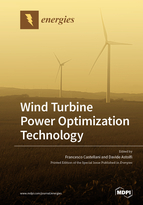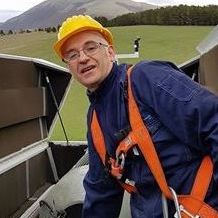Wind Turbine Power Optimization Technology
A special issue of Energies (ISSN 1996-1073). This special issue belongs to the section "A: Sustainable Energy".
Deadline for manuscript submissions: closed (19 December 2019) | Viewed by 29675
Special Issue Editors
Interests: wind turbine; vibrations; aeroelasticity; fault diagnosis; wakes; SCADA; applied aerodynamics; mechanical system dynamics
Special Issues, Collections and Topics in MDPI journals
Interests: wind turbines; condition monitoring; fault diagnosis; non-stationary machinery; control and monitoring; vibrations; applied statistics; numerical modelling; mechanical systems dynamics
Special Issues, Collections and Topics in MDPI journals
Special Issue Information
Dear Colleagues,
Multi-megawatt wind turbines are nowadays a mature technology, and, therefore, there is a considerable boost of the quest for further optimization of their wind kinetic energy conversion efficiency. A certain amount and different types of wind turbine power upgrades have been recently spreading in the industry. The interventions on the wind turbines for improving power extraction can basically deal with the aerodynamics of the blades (vortex generator, Gurney flaps, etc.) or with the control system (pitch or rotor revolutions per minute, yaw management optimization, etc.). Some test case studies have been recently collected in the wind energy literature, and the main result is that the efficiency of wind turbine power upgrades (especially as regards the aerodynamic ones) can depend considerably on the wind flow conditions at the microscale level. Therefore, on these grounds, it is useful not only to collect further test case discussions about this subject, which is at its early stages in the literature, but also to start considering several methodological and scientific issues that are currently overlooked. One critical point is that, since wind turbines operate under non-stationary conditions, it is impossible to quantify the efficiency of a power upgrade by comparing the energy production before and after the intervention. A model for the determination of power production of the wind turbines of interest is needed, and the upgrade impact should be detected and quantified as a change in the residuals between measurements and model estimates after the intervention. This issue calls for complex methodologies, because the power output of a wind turbine has multivariate dependency on atmospheric conditions and working parameters. Therefore, the study of wind turbine power upgrades stands at the crossroad with the most innovative methodologies for the control and monitoring of wind turbine operation. Another critical point is that, commonly, the quantification of the augmented mechanical loads provided by wind turbine power upgrades is missing. A complete evaluation of wind turbine power upgrades should actually quantify the pros (improved production) as well as the cons (impact on the residue lifetime of the components). This Special Issue, therefore, welcomes contributions based on operational data analysis and on numerical simulations. Contributions are welcome that deal with operating wind farms and present perspectives on the future developments of wind turbines control and aerodynamic improvements. Despite small wind turbines being characterized by different scientific and technological issues with respect to multi-megawatt wind turbines, contributions dealing with the control and optimization of small wind turbines are also welcome.
Prof. Dr. Francesco Castellani
Dr. Davide Astolfi
Guest Editors
Manuscript Submission Information
Manuscripts should be submitted online at www.mdpi.com by registering and logging in to this website. Once you are registered, click here to go to the submission form. Manuscripts can be submitted until the deadline. All submissions that pass pre-check are peer-reviewed. Accepted papers will be published continuously in the journal (as soon as accepted) and will be listed together on the special issue website. Research articles, review articles as well as short communications are invited. For planned papers, a title and short abstract (about 100 words) can be sent to the Editorial Office for announcement on this website.
Submitted manuscripts should not have been published previously, nor be under consideration for publication elsewhere (except conference proceedings papers). All manuscripts are thoroughly refereed through a single-blind peer-review process. A guide for authors and other relevant information for submission of manuscripts is available on the Instructions for Authors page. Energies is an international peer-reviewed open access semimonthly journal published by MDPI.
Please visit the Instructions for Authors page before submitting a manuscript. The Article Processing Charge (APC) for publication in this open access journal is 2600 CHF (Swiss Francs). Submitted papers should be well formatted and use good English. Authors may use MDPI's English editing service prior to publication or during author revisions.
Keywords
- wind energy
- wind turbines
- control and optimization
- aerodynamics







